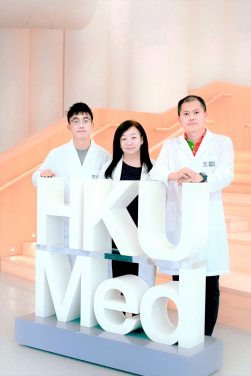Media
HKUMed uncovers a novel intercellular interplay mediated by small extracellular vesicles that opens up promising therapeutic possibilities for liver cancer
30 Aug 2023
A research team led by Professor Judy Yam Wai-ping from the Department of Pathology, School of Clinical Medicine, LKS Faculty of Medicine, the University of Hong Kong (HKUMed) has made a significant breakthrough in unveiling an unrecognised signalling pathway mediated by circulating small extracellular vesicles (sEVs) derived from liver cancer patients that promotes liver cancer metastasis. This discovery presents a potential therapeutic strategy for treating liver cancer, which has been published in Advanced Science [link to the publication].
Background
Liver cancer is the fifth commonest cancer and the third leading cause of cancer death in Hong Kong. As a hypervascular tumour, liver cancer is largely driven by the modulation of tumour-derived small extracellular vesicles (sEVs) within the tumour microenvironment. Enhanced vascularisation allows tumour cells to enter the bloodstream, facilitating their dissemination to distant loci and thus cancer metastasis. Growing evidence suggests a role of tumour-derived sEVs in modulating angiogenic signalling. Understanding the mechanisms by which sEVs regulate angiogenesis in liver cancer could lead to the development of new therapeutic strategies.
Research methods and findings
Proteomic profiling of circulating sEVs of control subjects and Hepatocellular Carcinoma (HCC) (the most common type of primary liver cancer) individuals revealed von Willibrand factor (vWF) to be upregulated progressively along the developmental stages of liver cancer. The drastic elevation of sEV-vWF level in HCC patients indicated its potentiality as a non-invasive diagnostic marker for liver cancer. The research team also showed the inducing ability of circulating sEVs of late-stage patients in liver cancer development and metastasis was dampened by anti-vWF antibody, demonstrating the crucial role of sEV-vWF in liver cancer.
vWF-enriched sEVs derived from liver cancer cells displayed a significant promoting effect on angiogenesis, tumour-endothelial adhesion and vascular permeability. The growth factors released by the endothelial cells could in turn promote cancer cell growth and motility. The study unveils an unrecognised mutual stimulation between tumour and endothelial cells initiated by sEV-vWF. Using mouse model of liver cancer, the team observed that the enhanced angiogenesis mediated by sEV-vWF facilitates liver cancer development and distant metastasis, which is crucial to liver cancer development and metastasis.
The team further demonstrated that the combination treatment of Sorafenib (the standard first-line treatment of advanced liver cancer patients), with anti-vWF antibody or the pan-FGFR inhibitor Erdafitinib, significantly improved the treatment outcome than Sorafenib treatment alone in patient-derived xenograft mouse model. The results suggested a novel therapeutic approach for liver cancer by blocking sEV-mediated tumour-endothelial intercellular communication.
Significance of the study
‘There is limited curative therapeutic option for cancer patients. Understanding the molecular basis of liver cancer will provide insights into new effective strategies to treat liver cancer. In this study, we identified a pivotal functional role of vWF carried by circulating sEV obtained from the advanced stage liver cancer patients in inducing neoangiogenesis. Our study not only discovered the role and molecular basis of vWF delivered by sEV in liver cancer but also suggested the blockade of intercellular communication within the tumour microenvironment is a new therapeutic approach for liver cancer,’ said Professor Judy Yam Wai-ping, Professor, Department of Pathology, School of Clinical Medicine, HKUMed.
About the research team
The research was led by Professor Judy Yam Wai-ping, Department of Pathology, School of Clinical Medicine, HKUMed, Principal Investigator, State Key Laboratory of Liver Research (the University of Hong Kong). Professor Yam was also the corresponding author of the research. Samuel Wong Wan-ki, PhD student, was the first author, with assistance from Dr Tey Sze-keong and Dr Mao Xiaowen, Research Assistant Professors and Fung Hiu-ling, Research Assistant, Department of Pathology, School of Clinical Medicine, HKUMed. Other research team members include Dr Danny Wong Ka-ho, Scientific Officer; Dr Loey Mak Lung-yi, Clinical Assistant Professor; Professor Yuen Man-fung, Li Shu Fan Medical Foundation Professor in Medicine, Chair and Chief of Division of Gastroenterology and Hepatology, Deputy Chairperson of Department of Medicine, School of Clinical Medicine, HKUMed; Professor Irene Ng Oi-lin, Loke Yew Professor in Pathology, Chair Professor of Pathology, Department of Pathology, School of Clinical Medicine, HKUMed, Director, State Key Laboratory of Liver Research (the University of Hong Kong). Collaborating institutions contributing to the research include Sun Yat-sen University, Sun Yat-sen University Cancer Center and Southern Medical University, Guangzhou.
Acknowledgement
The work was supported by Innovative Research Fund of State Key Laboratory of Liver Research (the University of Hong Kong) and Health and Medical Research Fund 2022 (Project no.: 09202326).
Media enquiries
Please contact LKS Faculty of Medicine of The University of Hong Kong by email (medmedia@hku.hk).

